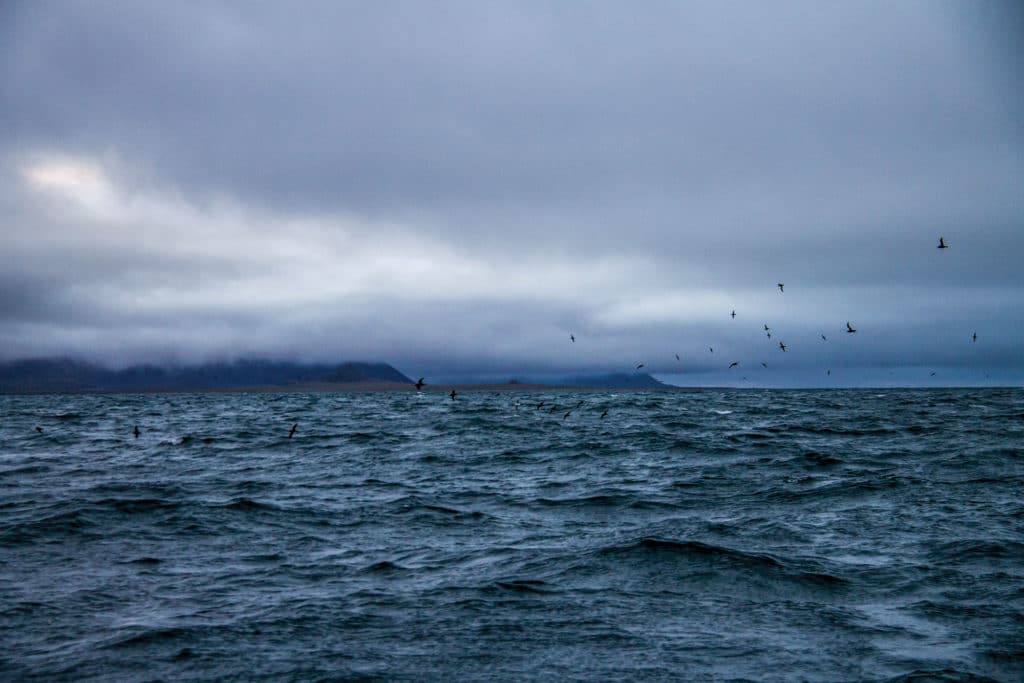
When cruising-guide author and voyager Diana Doyle first approached me about contributing to her citizen-science project, Birding Aboard, I hesitated. I didn’t think I was qualified, having only just gotten into birding in a very amateur, casual way. I’m a sailor, not a birder. True, I’m a sailor who likes birds, especially the pretty ones and the comic ones, but I didn’t consider myself a birder, and certainly not any kind of scientist. I’m not always correct with my identifications and have been downright embarrassingly wrong more than a few times. With few exceptions, I don’t have the single-minded passion to do the research necessary for definitive identifications of birds of which I’m unsure. If I see a loon in winter plumage and I’m not certain whether it’s an Arctic, a Pacific or a common loon, well, I’m OK with letting it go at “loon.”
For me, the fun is much more in sighting a wild creature, appreciating its beauty, and identifying and learning about it if I can, but not really in an avian-life-list sort of way. It’s a lot like my sailing: I like the actual sailing, the ever-changing beauty of the sea, the solitude, the challenges—in short, the experience of taking a small boat across an ocean. It’s not about ticking the boxes of “circumnavigation” or “high latitudes.”
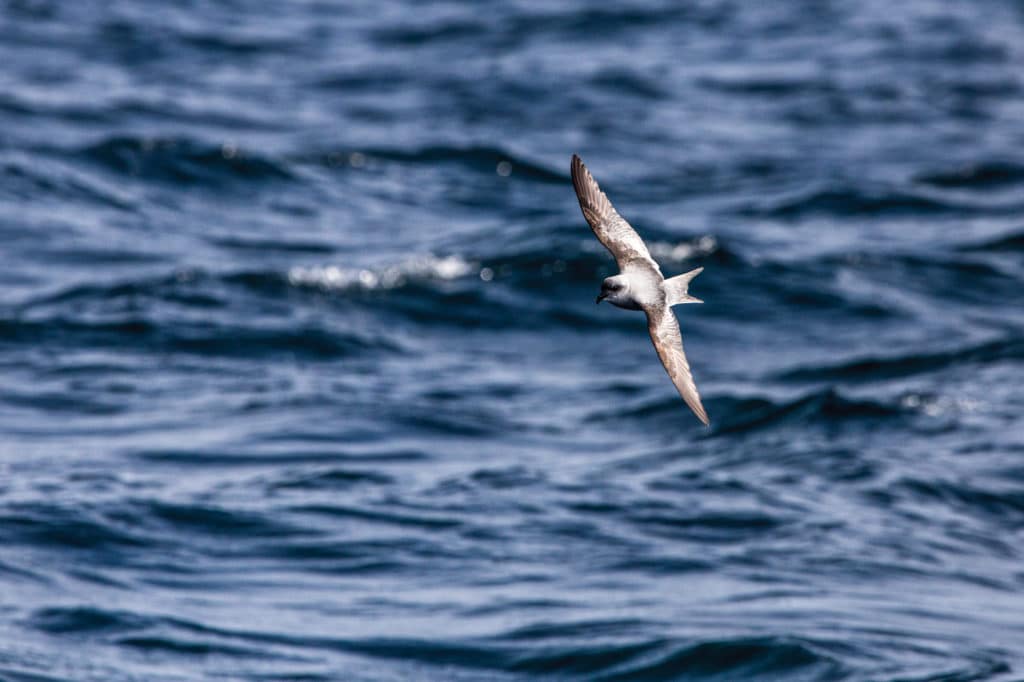
Diana managed to persuade me, though, mostly by assuring me that I could just submit incidental sightings. That way I wouldn’t have to spend my watches with notebook in hand, taking down every bird sighting complete with local time and coordinates. Instead, if I saw something that interested me enough to take a photo, I could go ahead and submit that. In short, any and all sightings are valuable to the Birding Aboard project, which catalogs the birds of the open ocean that are so underrepresented in bird counts around the world for the simple reason that not very many people spend significant time offshore.
My correspondence with Diana coincided with the voyage that my husband, Seth, and I made to Alaska and the Arctic. After extensively refitting our 30-year-old cold-molded wooden cutter Celeste, we set out from Port Angeles, Washington, for a 3,500-mile cruise to Dutch Harbor, in Alaska’s Aleutian Islands. That part of the world is incredibly rich in wildlife—avian and otherwise. In our very first port of call, an inlet on the west coast of Vancouver Island, we came face to face with seven—yes, seven—black bears, all intent on munching the rich grasses growing at the head of the cove. Overhead, eagles and ospreys circled on the thermals wafting up from the warm land, searching the water below for fish.
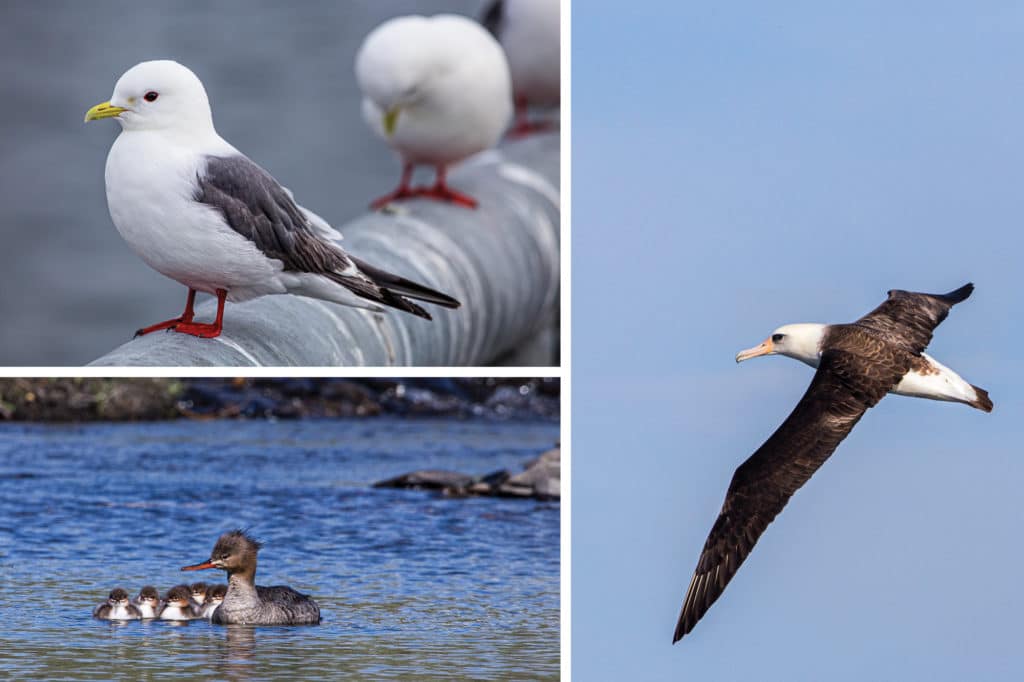
Throughout that cruise, most of our wildlife sightings—except, of course, for whales, porpoises and orcas—took place in our anchorages. We were sailing against the prevailing winds, and so we’d take “bad” weather windows to make progress west, weighing anchor whenever a low-pressure system was forecast in order to take advantage of the easterly winds that accompanied them. So our passages were pretty much all windy, rainy and cold, conditions that had us in full foul-weather gear, reefing down and changing our self-steering Cape Horn’s vane to the small heavy-weather vane. Not exactly wonderful weather for noting bird sightings. Nonetheless, we were excited to spot both Laysan and black-footed albatrosses on our Gulf of Alaska crossing, as well as northern fulmars, mostly the dark-morph sort.
As we moved farther west, we delighted in the comic little puffins—tufted and horned—and in the black-legged kittiwakes breeding in huge flocks on the cliffs of headlands and islands. The variety and beauty of the birds in the wilderness of the Great Land captivated both of us. By the time we were traversing the notoriously difficult passes between the Aleutian Islands, we were fruitlessly—but intently—scanning the waves for the elusive, endemic whiskered auklet, found only there.
Read More from Ellen Massey Leonard: Cruising the Alaskan Peninsula
On our voyage north the following summer, our first destination was the Pribilof Islands, a barren, cold, windswept place that was uninhabited (for good reason) until the Russians colonized Alaska and began harvesting northern fur seals for their valuable hides. Today a small population of Aleuts continues to live there—fishing, hunting and supporting a tiny tourism industry based on, yes, birding.
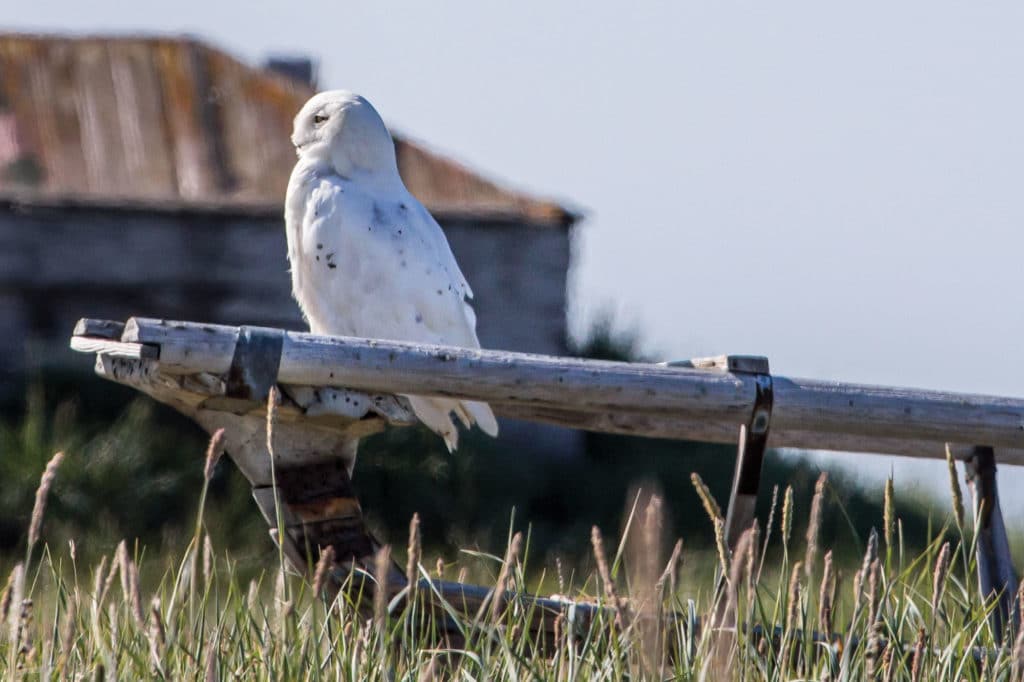
The Pribilofs is the breeding ground for enormous colonies of seabirds: murres, puffins, red-faced cormorants, several different auklets, and the endemic red-legged kittiwake. For serious birders, it’s a paradise for checking off “lifers” on their lists. The red-legged kittiwake is found almost nowhere else, and the various auklets are unique to the Bering Sea and North Pacific. Seth and I don’t have life lists, but we got unabashedly into it, lying atop the sea cliffs in the sand and high grasses, craning our necks and zoom lenses to get a good look at these beautiful birds. Even fog and high winds couldn’t keep us away; we’d tramp over from the little harbor to the cliffs, bent double into the wind and swirling dust. A fun fact about this part of the world is that 35-knot winds don’t necessarily disperse fog!
At the Fourth of July festivities in the village of St. Paul, on St. Paul Island, the largest of the Pribilofs, we met Alison, a young woman leading bird tours on the island. Not having any clients during our visit—the plane couldn’t land due to high winds and fog—she offered to show us around the island in her van. It was, of course, a bird tour. She first took us to her favorite place for seeing least auklets, where we promptly got the van stuck in the wet sand and had to place flat bits of driftwood under the tires to get it out. There were lots of the cute little auklets, though, only 6 inches tall and with strikingly colored eyes. But we quickly discovered that the seabirds nesting in the cliffs were far from the only avian attraction. There were teals, eiders and long-tailed ducks, Arctic terns, semipalmated plovers and snow buntings. Alison even found a two-day-old rock sandpiper chick.
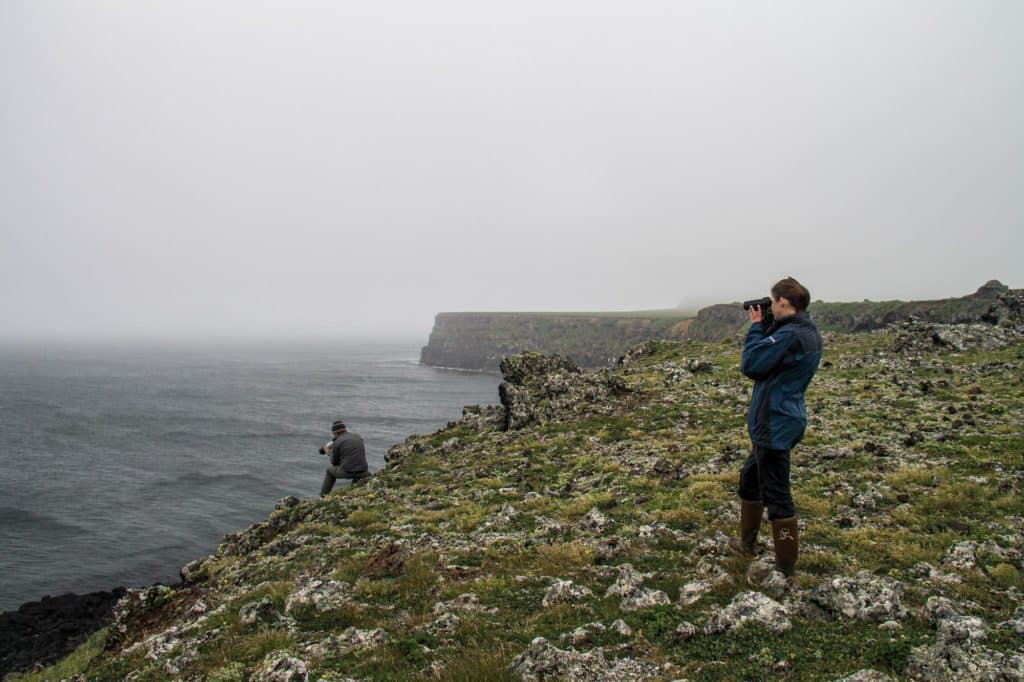
Chatting away about birds later that evening with Alison and her colleagues, we managed to make one of the colleagues—a very serious birder—absolutely green with envy when we mentioned seeing lots of fork-tailed storm petrels on our passage north from the Aleutians. These lovely, graceful birds flit effortlessly over the gale-tossed waves of the Bering Sea and, like so many pelagic birds, had completely ignored Celeste in their midst, swooping close and then away and then close again. This poor land-bound birder, it turned out, had spent the previous two days sitting behind her telescope, staring into the 40-knot stinker of a gale—fog and sand whipping around her, getting into her hair and teeth and clothes—while she hoped and prayed for a fork-tailed storm petrel to get blown down toward her. None had.
Our next stop on our Arctic voyage was the gold-rush town of Nome, where we planned to check the ice charts and satellite photographs before continuing on through the Bering Strait. The Seward Peninsula, where Nome is situated, is also one of the few places in Alaska where one can see muskoxen, a large and distinctive Arctic herbivore that’s a kind of relic of the Ice Age. Being all-round wildlife appreciators more than true birders, we first sought out the muskoxen, and they more than lived up to our expectations. But we couldn’t help but notice the birds too. Arctic terns not only have beautiful plumage, but also the longest migration route of any bird, all the way to the Antarctic and back every year! The golden plover also migrates far, from the South Pacific to Alaska via Hawaii, and is said to have guided the first Polynesians who settled Hawaii. Our most adorable sighting, though, was the merganser with her little flock of day-old fluffy chicks swimming next to her in a tight pack.
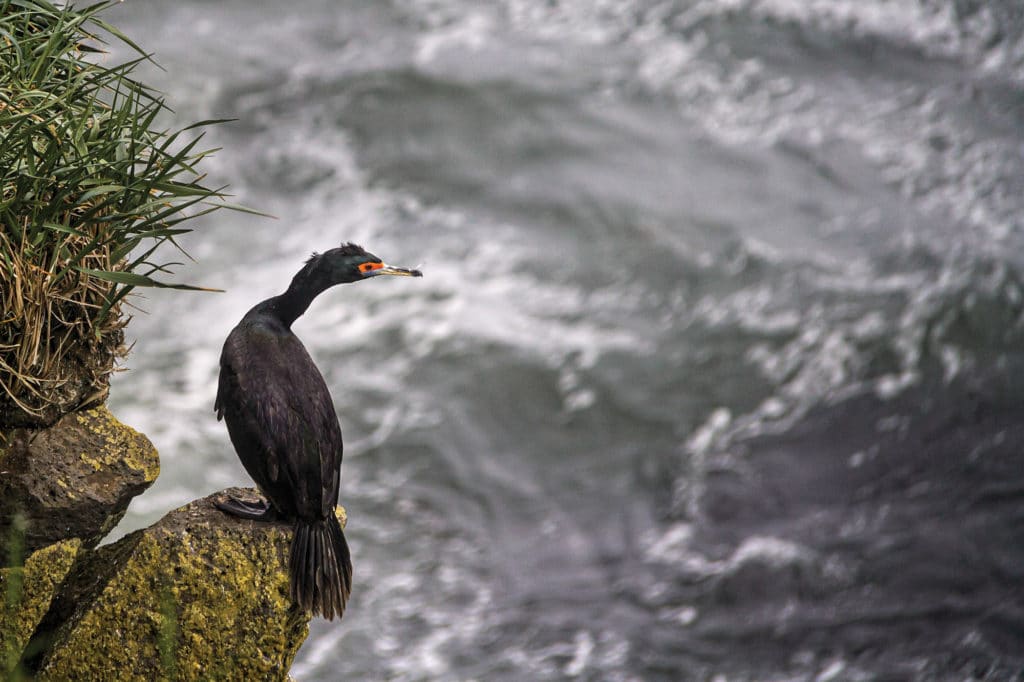
Once through the Bering Strait and up in the Chukchi Sea, the bird life just continued. As we passed Cape Lisburne—the barren brown headland where the Brooks Range meets the sea—in a rare mirror calm, the blue sky was darkened by the huge flocks of murres, flying back and forth to their nests in the cliffs. Neither of us had ever seen such enormous aggregations of birds—such a stark contrast of vibrant, dynamic life in the seemingly lifeless, harsh tundra of the Arctic.
Point Barrow, the most northerly point in the United States and the second-most northerly point on the continent, felt the same. The tundra was as alive as it ever gets, the grasses green, red and yellow, and yet the flat, windy land felt as though it couldn’t possibly support much life. Yet every way we turned dispelled that notion. Pacific white-fronted geese waddled through the grass. King eiders in their spectacular breeding plumage dotted the gray waves of the Beaufort Sea. Once again, the sky turned black with flocks of long-tailed ducks and black brants. Phalaropes, already transitioning into winter plumage, turned their characteristic circles in the shallows nearshore. Black guillemots nested on the offshore islands, and occasionally a snowy owl would swoop across the tundra, going from perch to perch, hunting ground squirrels. Out at sea, high over the frozen Arctic Ocean on the top of the world, white-morph northern fulmars glided majestically over the drifting ice floes.
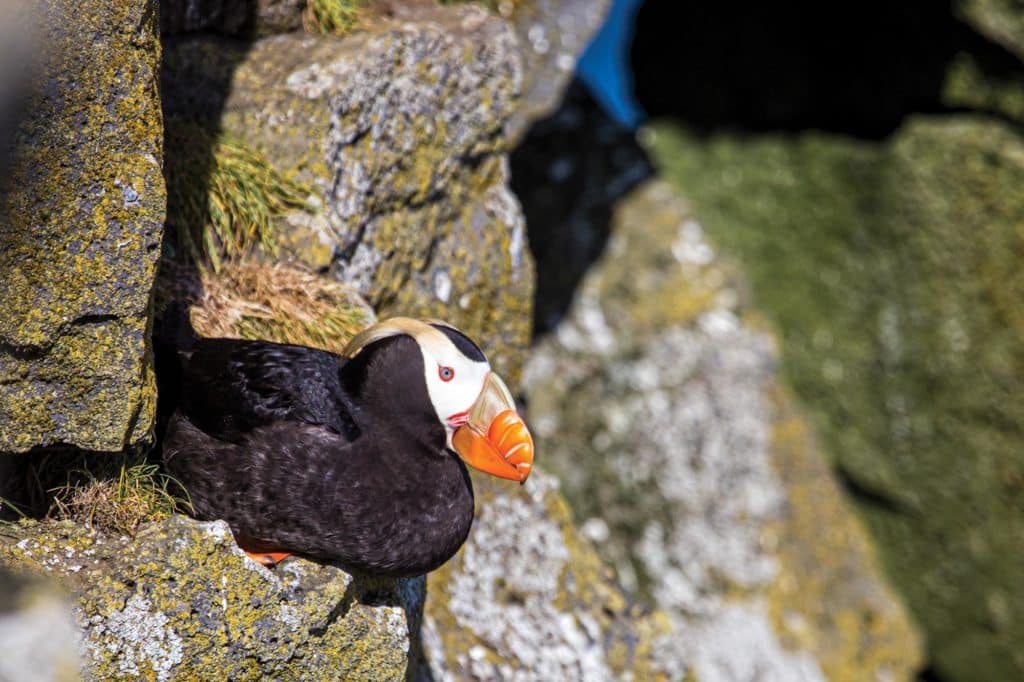
We hadn’t intended for our Arctic voyage to be focused on birds. Seth and I had simply had in mind that we would see this remarkable, little-visited part of the world from the deck of our floating home. We’d been focused on the challenges inherent in sailing up there, in the harsh, volatile weather, and the cold and ice, with few bays in which to shelter.
Both of us had been looking forward to the mammal life: muskoxen, whales, various seals, maybe even walruses and polar bears. We’d been interested to meet the people native to this tundra land and hear how their lives have both changed and remained much like that of their parents and grandparents. And all of that (except, sadly, for the lack of walrus and polar bear sightings) had gone beyond anything we’d anticipated: the people more welcoming, the whales and muskoxen more numerous, and weather both worse and more rewarding than we’d wanted to believe. But to find a world so alive with so many beautiful birds was an unexpected and wonderful dividend to the voyage. And to find, when we submitted our sightings to Birding Aboard, that we’d seen a variety and quantity of birds to impress any life-list type of birder was rather more gratifying than we as amateur bird nerds really should have found it.
Writer and photographer Ellen Massey Leonard has sailed nearly 60,000 miles on rudimentary classic boats, including a circumnavigation by age 24, a voyage to the Alaskan Arctic, and two more crossings of the Pacific. She and her husband, Seth, were the 2018 recipients of the Cruising Club of America’s prestigious Young Voyager Award.








